Preferred temperature (Ref.
115969): 16.5 - 27.9, mean 24.8 (based on 2020 cells).
Phylogenetic diversity index (Ref.
82804): PD
50 = 0.5000 [Uniqueness, from 0.5 = low to 2.0 = high].
Bayesian length-weight: a=0.01738 (0.01424 - 0.02121), b=2.94 (2.91 - 2.97), in cm Total Length, based on LWR estimates for this species (Ref.
93245).
Mức dinh dưỡng (Ref.
69278): 3.6 ±0.4 se; based on diet studies.
Thích nghi nhanh (Ref.
120179): Trung bình, thời gian nhân đôi của chủng quần tối thiểu là 1.4 - 4.4 năm (Assuming tm 3-4).
Prior r = 0.53, 95% CL = 0.35 - 0.80, Based on 5 data-limited stock assessments.
Fishing Vulnerability (Ref.
59153): Moderate vulnerability (41 of 100).
Climate Vulnerability (Ref.
125649): High vulnerability (62 of 100).
